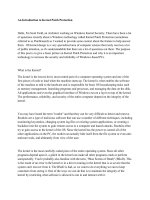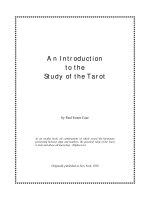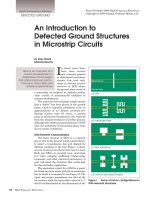An introduction to informations retrival
Bạn đang xem bản rút gọn của tài liệu. Xem và tải ngay bản đầy đủ của tài liệu tại đây (6.58 MB, 581 trang )
An
Introduction
to
Information
Retrieval
Draft of April 1, 2009
Online edition (c) 2009 Cambridge UP
Online edition (c) 2009 Cambridge UP
An
Introduction
to
Information
Retrieval
Christopher D. Manning
Prabhakar Raghavan
Hinrich Schütze
Cambridge University Press
Cambridge, England
Online edition (c) 2009 Cambridge UP
DRAFT!
DO NOT DISTRIBUTE WITHOUT PRIOR PERMISSION
© 2009 Cambridge University Press
By Christopher D. Manning, Prabhakar Raghavan & Hinrich Schütze
Printed on April 1, 2009
Website: />Comments, corrections, and other feedback most welcome at:
Online edition (c) 2009 Cambridge UP
v
DRAFT! © April 1, 2009 Cambridge University Press. Feedback welcome.
Brief Contents
1
2
3
4
5
6
7
8
9
10
11
12
13
14
15
16
17
18
19
20
21
1
Boolean retrieval
The term vocabulary and postings lists
19
Dictionaries and tolerant retrieval
49
Index construction
67
Index compression
85
Scoring, term weighting and the vector space model
109
Computing scores in a complete search system
135
Evaluation in information retrieval
151
Relevance feedback and query expansion
177
XML retrieval
195
Probabilistic information retrieval
219
Language models for information retrieval
237
Text classification and Naive Bayes
253
Vector space classification
289
Support vector machines and machine learning on documents
Flat clustering
349
Hierarchical clustering
377
Matrix decompositions and latent semantic indexing
403
Web search basics
421
Web crawling and indexes
443
Link analysis
461
Online edition (c) 2009 Cambridge UP
319
Online edition (c) 2009 Cambridge UP
vii
DRAFT! © April 1, 2009 Cambridge University Press. Feedback welcome.
Contents
List of Tables
List of Figures
xv
xix
Table of Notation
Preface
xxxi
1 Boolean retrieval
1.1
1.2
1.3
1.4
1.5
xxvii
1
An example information retrieval problem
3
A first take at building an inverted index
6
Processing Boolean queries
10
The extended Boolean model versus ranked retrieval
References and further reading
17
2 The term vocabulary and postings lists
2.1
2.2
2.3
2.4
2.5
14
19
Document delineation and character sequence decoding
2.1.1
Obtaining the character sequence in a document
2.1.2
Choosing a document unit
20
Determining the vocabulary of terms
22
2.2.1
Tokenization
22
2.2.2
Dropping common terms: stop words
27
2.2.3
Normalization (equivalence classing of terms)
2.2.4
Stemming and lemmatization
32
Faster postings list intersection via skip pointers
36
Positional postings and phrase queries
39
2.4.1
Biword indexes
39
2.4.2
Positional indexes
41
2.4.3
Combination schemes
43
References and further reading
45
Online edition (c) 2009 Cambridge UP
19
19
28
viii
Contents
49
3 Dictionaries and tolerant retrieval
3.1 Search structures for dictionaries
49
3.2 Wildcard queries
51
3.2.1
General wildcard queries
53
3.2.2
k-gram indexes for wildcard queries
54
3.3 Spelling correction
56
3.3.1
Implementing spelling correction
57
3.3.2
Forms of spelling correction
57
3.3.3
Edit distance
58
3.3.4
k-gram indexes for spelling correction
60
3.3.5
Context sensitive spelling correction
62
3.4 Phonetic correction
63
3.5 References and further reading
65
4 Index construction
67
4.1 Hardware basics
68
4.2 Blocked sort-based indexing
69
4.3 Single-pass in-memory indexing
73
4.4 Distributed indexing
74
4.5 Dynamic indexing
78
4.6 Other types of indexes
80
4.7 References and further reading
83
5 Index compression
85
5.1 Statistical properties of terms in information retrieval
5.1.1
Heaps’ law: Estimating the number of terms
5.1.2
Zipf’s law: Modeling the distribution of terms
5.2 Dictionary compression
90
5.2.1
Dictionary as a string
91
5.2.2
Blocked storage
92
5.3 Postings file compression
95
5.3.1
Variable byte codes
96
5.3.2
γ codes
98
5.4 References and further reading
105
6 Scoring, term weighting and the vector space model
6.1 Parametric and zone indexes
110
6.1.1
Weighted zone scoring
112
6.1.2
Learning weights
113
6.1.3
The optimal weight g
115
6.2 Term frequency and weighting
117
6.2.1
Inverse document frequency
117
6.2.2
Tf-idf weighting
118
Online edition (c) 2009 Cambridge UP
109
86
88
89
ix
Contents
6.3
6.4
6.5
120
The vector space model for scoring
6.3.1
Dot products
120
6.3.2
Queries as vectors
123
6.3.3
Computing vector scores
124
Variant tf-idf functions
126
6.4.1
Sublinear tf scaling
126
6.4.2
Maximum tf normalization
127
6.4.3
Document and query weighting schemes
128
6.4.4
Pivoted normalized document length
129
References and further reading
133
7 Computing scores in a complete search system
7.1
7.2
7.3
7.4
Efficient scoring and ranking
135
7.1.1
Inexact top K document retrieval
137
7.1.2
Index elimination
137
7.1.3
Champion lists
138
7.1.4
Static quality scores and ordering
138
7.1.5
Impact ordering
140
7.1.6
Cluster pruning
141
Components of an information retrieval system
143
7.2.1
Tiered indexes
143
7.2.2
Query-term proximity
144
7.2.3
Designing parsing and scoring functions
145
7.2.4
Putting it all together
146
Vector space scoring and query operator interaction
147
References and further reading
149
8 Evaluation in information retrieval
8.1
8.2
8.3
8.4
8.5
8.6
8.7
8.8
135
151
Information retrieval system evaluation
152
Standard test collections
153
Evaluation of unranked retrieval sets
154
Evaluation of ranked retrieval results
158
Assessing relevance
164
8.5.1
Critiques and justifications of the concept of
relevance
166
A broader perspective: System quality and user utility
8.6.1
System issues
168
8.6.2
User utility
169
8.6.3
Refining a deployed system
170
Results snippets
170
References and further reading
173
9 Relevance feedback and query expansion
177
Online edition (c) 2009 Cambridge UP
168
x
Contents
9.1
9.2
9.3
178
Relevance feedback and pseudo relevance feedback
9.1.1
The Rocchio algorithm for relevance feedback
178
9.1.2
Probabilistic relevance feedback
183
9.1.3
When does relevance feedback work?
183
9.1.4
Relevance feedback on the web
185
9.1.5
Evaluation of relevance feedback strategies
186
9.1.6
Pseudo relevance feedback
187
9.1.7
Indirect relevance feedback
187
9.1.8
Summary
188
Global methods for query reformulation
189
9.2.1
Vocabulary tools for query reformulation
189
9.2.2
Query expansion
189
9.2.3
Automatic thesaurus generation
192
References and further reading
193
10 XML retrieval
195
10.1 Basic XML concepts
197
10.2 Challenges in XML retrieval
201
10.3 A vector space model for XML retrieval
206
10.4 Evaluation of XML retrieval
210
10.5 Text-centric vs. data-centric XML retrieval
214
10.6 References and further reading
216
10.7 Exercises
217
11 Probabilistic information retrieval
219
11.1 Review of basic probability theory
220
11.2 The Probability Ranking Principle
221
11.2.1 The 1/0 loss case
221
11.2.2 The PRP with retrieval costs
222
11.3 The Binary Independence Model
222
11.3.1 Deriving a ranking function for query terms
224
11.3.2 Probability estimates in theory
226
11.3.3 Probability estimates in practice
227
11.3.4 Probabilistic approaches to relevance feedback
228
11.4 An appraisal and some extensions
230
11.4.1 An appraisal of probabilistic models
230
11.4.2 Tree-structured dependencies between terms
231
11.4.3 Okapi BM25: a non-binary model
232
11.4.4 Bayesian network approaches to IR
234
11.5 References and further reading
235
12 Language models for information retrieval
12.1 Language models
237
237
Online edition (c) 2009 Cambridge UP
xi
Contents
12.2
12.3
12.4
12.5
237
12.1.1 Finite automata and language models
12.1.2 Types of language models
240
12.1.3 Multinomial distributions over words
241
The query likelihood model
242
12.2.1 Using query likelihood language models in IR
242
12.2.2 Estimating the query generation probability
243
12.2.3 Ponte and Croft’s Experiments
246
Language modeling versus other approaches in IR
248
Extended language modeling approaches
250
References and further reading
252
13 Text classification and Naive Bayes
253
13.1 The text classification problem
256
13.2 Naive Bayes text classification
258
13.2.1 Relation to multinomial unigram language model
13.3 The Bernoulli model
263
13.4 Properties of Naive Bayes
265
13.4.1 A variant of the multinomial model
270
13.5 Feature selection
271
13.5.1 Mutual information
272
13.5.2 χ2 Feature selection
275
13.5.3 Frequency-based feature selection
277
13.5.4 Feature selection for multiple classifiers
278
13.5.5 Comparison of feature selection methods
278
13.6 Evaluation of text classification
279
13.7 References and further reading
286
262
14 Vector space classification
289
14.1 Document representations and measures of relatedness in
vector spaces
291
14.2 Rocchio classification
292
14.3 k nearest neighbor
297
14.3.1 Time complexity and optimality of kNN
299
14.4 Linear versus nonlinear classifiers
301
14.5 Classification with more than two classes
306
14.6 The bias-variance tradeoff
308
14.7 References and further reading
314
14.8 Exercises
315
15 Support vector machines and machine learning on documents
319
15.1 Support vector machines: The linearly separable case
320
15.2 Extensions to the SVM model
327
15.2.1 Soft margin classification
327
Online edition (c) 2009 Cambridge UP
xii
Contents
330
15.2.2 Multiclass SVMs
15.2.3 Nonlinear SVMs
330
15.2.4 Experimental results
333
15.3 Issues in the classification of text documents
334
15.3.1 Choosing what kind of classifier to use
335
15.3.2 Improving classifier performance
337
15.4 Machine learning methods in ad hoc information retrieval
341
15.4.1 A simple example of machine-learned scoring
341
15.4.2 Result ranking by machine learning
344
15.5 References and further reading
346
16 Flat clustering
349
16.1 Clustering in information retrieval
350
16.2 Problem statement
354
16.2.1 Cardinality – the number of clusters
355
16.3 Evaluation of clustering
356
16.4 K-means
360
16.4.1 Cluster cardinality in K-means
365
16.5 Model-based clustering
368
16.6 References and further reading
372
16.7 Exercises
374
17 Hierarchical clustering
377
17.1 Hierarchical agglomerative clustering
378
17.2 Single-link and complete-link clustering
382
17.2.1 Time complexity of HAC
385
17.3 Group-average agglomerative clustering
388
17.4 Centroid clustering
391
17.5 Optimality of HAC
393
17.6 Divisive clustering
395
17.7 Cluster labeling
396
17.8 Implementation notes
398
17.9 References and further reading
399
17.10 Exercises
401
18 Matrix decompositions and latent semantic indexing
18.1 Linear algebra review
403
18.1.1 Matrix decompositions
406
18.2 Term-document matrices and singular value
decompositions
407
18.3 Low-rank approximations
410
18.4 Latent semantic indexing
412
18.5 References and further reading
417
Online edition (c) 2009 Cambridge UP
403
xiii
Contents
421
19 Web search basics
19.1 Background and history
421
19.2 Web characteristics
423
19.2.1 The web graph
425
19.2.2 Spam
427
19.3 Advertising as the economic model
429
19.4 The search user experience
432
19.4.1 User query needs
432
19.5 Index size and estimation
433
19.6 Near-duplicates and shingling
437
19.7 References and further reading
441
20 Web crawling and indexes
443
20.1 Overview
443
20.1.1 Features a crawler must provide
20.1.2 Features a crawler should provide
20.2 Crawling
444
20.2.1 Crawler architecture
445
20.2.2 DNS resolution
449
20.2.3 The URL frontier
451
20.3 Distributing indexes
454
20.4 Connectivity servers
455
20.5 References and further reading
458
443
444
21 Link analysis
461
21.1 The Web as a graph
462
21.1.1 Anchor text and the web graph
462
21.2 PageRank
464
21.2.1 Markov chains
465
21.2.2 The PageRank computation
468
21.2.3 Topic-specific PageRank
471
21.3 Hubs and Authorities
474
21.3.1 Choosing the subset of the Web
477
21.4 References and further reading
480
Bibliography
483
Author Index
519
Online edition (c) 2009 Cambridge UP
Online edition (c) 2009 Cambridge UP
DRAFT! © April 1, 2009 Cambridge University Press. Feedback welcome.
xv
List of Tables
4.1
4.2
4.3
4.4
5.1
5.2
5.3
5.4
Typical system parameters in 2007. The seek time is the time
needed to position the disk head in a new position. The
transfer time per byte is the rate of transfer from disk to
memory when the head is in the right position.
Collection statistics for Reuters-RCV1. Values are rounded for
the computations in this book. The unrounded values are:
806,791 documents, 222 tokens per document, 391,523
(distinct) terms, 6.04 bytes per token with spaces and
punctuation, 4.5 bytes per token without spaces and
punctuation, 7.5 bytes per term, and 96,969,056 tokens. The
numbers in this table correspond to the third line (“case
folding”) in Table 5.1 (page 87).
The five steps in constructing an index for Reuters-RCV1 in
blocked sort-based indexing. Line numbers refer to Figure 4.2.
Collection statistics for a large collection.
The effect of preprocessing on the number of terms,
nonpositional postings, and tokens for Reuters-RCV1. “∆%”
indicates the reduction in size from the previous line, except
that “30 stop words” and “150 stop words” both use “case
folding” as their reference line. “T%” is the cumulative
(“total”) reduction from unfiltered. We performed stemming
with the Porter stemmer (Chapter 2, page 33).
Dictionary compression for Reuters-RCV1.
Encoding gaps instead of document IDs. For example, we
store gaps 107, 5, 43, . . . , instead of docIDs 283154, 283159,
283202, . . . for computer. The first docID is left unchanged
(only shown for arachnocentric).
VB encoding.
Online edition (c) 2009 Cambridge UP
68
70
82
82
87
95
96
97
xvi
List of Tables
5.5
5.6
5.7
Some examples of unary and γ codes. Unary codes are only
shown for the smaller numbers. Commas in γ codes are for
readability only and are not part of the actual codes.
Index and dictionary compression for Reuters-RCV1. The
compression ratio depends on the proportion of actual text in
the collection. Reuters-RCV1 contains a large amount of XML
markup. Using the two best compression schemes, γ
encoding and blocking with front coding, the ratio
compressed index to collection size is therefore especially
small for Reuters-RCV1: (101 + 5.9)/3600 ≈ 0.03.
Two gap sequences to be merged in blocked sort-based
indexing
98
103
105
6.1
Cosine computation for Exercise 6.19.
132
8.1
8.2
Calculation of 11-point Interpolated Average Precision.
Calculating the kappa statistic.
159
165
10.1
RDB (relational database) search, unstructured information
retrieval and structured information retrieval.
INEX 2002 collection statistics.
INEX 2002 results of the vector space model in Section 10.3 for
content-and-structure (CAS) queries and the quantization
function Q.
A comparison of content-only and full-structure search in
INEX 2003/2004.
10.2
10.3
10.4
13.1
13.2
13.3
13.4
13.5
13.6
13.7
Data for parameter estimation examples.
Training and test times for NB.
Multinomial versus Bernoulli model.
Correct estimation implies accurate prediction, but accurate
prediction does not imply correct estimation.
A set of documents for which the NB independence
assumptions are problematic.
Critical values of the χ2 distribution with one degree of
freedom. For example, if the two events are independent,
then P( X 2 > 6.63) < 0.01. So for X 2 > 6.63 the assumption of
independence can be rejected with 99% confidence.
The ten largest classes in the Reuters-21578 collection with
number of documents in training and test sets.
Online edition (c) 2009 Cambridge UP
196
211
213
214
261
261
268
269
270
277
280
List of Tables
Macro- and microaveraging. “Truth” is the true class and
“call” the decision of the classifier. In this example,
macroaveraged precision is
[10/(10 + 10) + 90/(10 + 90)]/2 = (0.5 + 0.9)/2 = 0.7.
Microaveraged precision is 100/(100 + 20) ≈ 0.83.
13.9 Text classification effectiveness numbers on Reuters-21578 for
F1 (in percent). Results from Li and Yang (2003) (a), Joachims
(1998) (b: kNN) and Dumais et al. (1998) (b: NB, Rocchio,
trees, SVM).
13.10 Data for parameter estimation exercise.
xvii
13.8
282
282
284
14.1
14.2
14.3
14.4
14.5
Vectors and class centroids for the data in Table 13.1.
Training and test times for Rocchio classification.
Training and test times for kNN classification.
A linear classifier.
A confusion matrix for Reuters-21578.
294
296
299
303
308
15.1
Training and testing complexity of various classifiers
including SVMs.
SVM classifier break-even F1 from (Joachims 2002a, p. 114).
Training examples for machine-learned scoring.
329
334
342
15.2
15.3
16.1
16.2
351
16.3
Some applications of clustering in information retrieval.
The four external evaluation measures applied to the
clustering in Figure 16.4.
The EM clustering algorithm.
17.1
17.2
Comparison of HAC algorithms.
Automatically computed cluster labels.
395
397
Online edition (c) 2009 Cambridge UP
357
371
Online edition (c) 2009 Cambridge UP
DRAFT! © April 1, 2009 Cambridge University Press. Feedback welcome.
xix
List of Figures
1.1
1.2
1.3
1.4
1.5
1.6
1.7
2.1
2.2
2.3
2.4
2.5
2.6
2.7
2.8
2.9
2.10
2.11
2.12
A term-document incidence matrix.
Results from Shakespeare for the query Brutus AND Caesar
AND NOT Calpurnia.
The two parts of an inverted index.
Building an index by sorting and grouping.
Intersecting the postings lists for Brutus and Calpurnia from
Figure 1.3.
Algorithm for the intersection of two postings lists p1 and p2 .
Algorithm for conjunctive queries that returns the set of
documents containing each term in the input list of terms.
An example of a vocalized Modern Standard Arabic word.
The conceptual linear order of characters is not necessarily the
order that you see on the page.
The standard unsegmented form of Chinese text using the
simplified characters of mainland China.
Ambiguities in Chinese word segmentation.
A stop list of 25 semantically non-selective words which are
common in Reuters-RCV1.
An example of how asymmetric expansion of query terms can
usefully model users’ expectations.
Japanese makes use of multiple intermingled writing systems
and, like Chinese, does not segment words.
A comparison of three stemming algorithms on a sample text.
Postings lists with skip pointers.
Postings lists intersection with skip pointers.
Positional index example.
An algorithm for proximity intersection of postings lists p1
and p2 .
Online edition (c) 2009 Cambridge UP
4
5
7
8
10
11
12
21
21
26
26
26
28
31
34
36
37
41
42
xx
List of Figures
3.1
3.2
3.3
3.4
3.5
3.6
3.7
4.1
4.2
4.3
4.4
4.5
4.6
4.7
4.8
5.1
5.2
5.3
5.4
5.5
5.6
5.7
5.8
5.9
5.10
6.1
6.2
6.3
A binary search tree.
A B-tree.
A portion of a permuterm index.
Example of a postings list in a 3-gram index.
Dynamic programming algorithm for computing the edit
distance between strings s1 and s2 .
Example Levenshtein distance computation.
Matching at least two of the three 2-grams in the query bord.
51
52
54
55
Document from the Reuters newswire.
Blocked sort-based indexing.
Merging in blocked sort-based indexing.
Inversion of a block in single-pass in-memory indexing
An example of distributed indexing with MapReduce.
Adapted from Dean and Ghemawat (2004).
Map and reduce functions in MapReduce.
Logarithmic merging. Each token (termID,docID) is initially
added to in-memory index Z0 by LM ERGE A DD T OKEN.
L OGARITHMIC M ERGE initializes Z0 and indexes.
A user-document matrix for access control lists. Element (i, j)
is 1 if user i has access to document j and 0 otherwise. During
query processing, a user’s access postings list is intersected
with the results list returned by the text part of the index.
70
71
72
73
Heaps’ law.
Zipf’s law for Reuters-RCV1.
Storing the dictionary as an array of fixed-width entries.
Dictionary-as-a-string storage.
Blocked storage with four terms per block.
Search of the uncompressed dictionary (a) and a dictionary
compressed by blocking with k = 4 (b).
Front coding.
VB encoding and decoding.
Entropy H ( P) as a function of P( x1 ) for a sample space with
two outcomes x1 and x2 .
Stratification of terms for estimating the size of a γ encoded
inverted index.
88
90
91
92
93
Parametric search.
Basic zone index
Zone index in which the zone is encoded in the postings
rather than the dictionary.
Online edition (c) 2009 Cambridge UP
59
59
61
76
77
79
81
94
94
97
100
102
111
111
111
List of Figures
6.4
6.5
6.6
6.7
6.8
6.9
6.10
6.11
6.12
6.13
6.14
6.15
6.16
6.17
Algorithm for computing the weighted zone score from two
postings lists.
An illustration of training examples.
The four possible combinations of s T and s B .
Collection frequency (cf) and document frequency (df) behave
differently, as in this example from the Reuters collection.
Example of idf values.
Table of tf values for Exercise 6.10.
Cosine similarity illustrated.
Euclidean normalized tf values for documents in Figure 6.9.
Term frequencies in three novels.
Term vectors for the three novels of Figure 6.12.
The basic algorithm for computing vector space scores.
SMART notation for tf-idf variants.
Pivoted document length normalization.
Implementing pivoted document length normalization by
linear scaling.
xxi
113
115
115
118
119
120
121
122
122
123
125
128
130
131
7.1
7.2
7.3
7.4
7.5
A faster algorithm for vector space scores.
A static quality-ordered index.
Cluster pruning.
Tiered indexes.
A complete search system.
136
139
142
144
147
8.1
8.2
8.3
Graph comparing the harmonic mean to other means.
Precision/recall graph.
Averaged 11-point precision/recall graph across 50 queries
for a representative TREC system.
The ROC curve corresponding to the precision-recall curve in
Figure 8.2.
An example of selecting text for a dynamic snippet.
157
158
Relevance feedback searching over images.
Example of relevance feedback on a text collection.
The Rocchio optimal query for separating relevant and
nonrelevant documents.
An application of Rocchio’s algorithm.
Results showing pseudo relevance feedback greatly
improving performance.
An example of query expansion in the interface of the Yahoo!
web search engine in 2006.
Examples of query expansion via the PubMed thesaurus.
An example of an automatically generated thesaurus.
179
180
8.4
8.5
9.1
9.2
9.3
9.4
9.5
9.6
9.7
9.8
Online edition (c) 2009 Cambridge UP
160
162
172
181
182
187
190
191
192
xxii
List of Figures
An XML document.
The XML document in Figure 10.1 as a simplified DOM object.
An XML query in NEXI format and its partial representation
as a tree.
10.4 Tree representation of XML documents and queries.
10.5 Partitioning an XML document into non-overlapping
indexing units.
10.6 Schema heterogeneity: intervening nodes and mismatched
names.
10.7 A structural mismatch between two queries and a document.
10.8 A mapping of an XML document (left) to a set of lexicalized
subtrees (right).
10.9 The algorithm for scoring documents with S IM N O M ERGE.
10.10 Scoring of a query with one structural term in S IM N O M ERGE.
10.11 Simplified schema of the documents in the INEX collection.
198
198
11.1
A tree of dependencies between terms.
232
12.1
A simple finite automaton and some of the strings in the
language it generates.
A one-state finite automaton that acts as a unigram language
model.
Partial specification of two unigram language models.
Results of a comparison of tf-idf with language modeling
(LM) term weighting by Ponte and Croft (1998).
Three ways of developing the language modeling approach:
(a) query likelihood, (b) document likelihood, and (c) model
comparison.
10.1
10.2
10.3
12.2
12.3
12.4
12.5
13.1
13.2
199
200
202
204
206
207
209
209
211
238
238
239
247
250
257
13.9
Classes, training set, and test set in text classification .
Naive Bayes algorithm (multinomial model): Training and
testing.
NB algorithm (Bernoulli model): Training and testing.
The multinomial NB model.
The Bernoulli NB model.
Basic feature selection algorithm for selecting the k best features.
Features with high mutual information scores for six
Reuters-RCV1 classes.
Effect of feature set size on accuracy for multinomial and
Bernoulli models.
A sample document from the Reuters-21578 collection.
14.1
Vector space classification into three classes.
290
13.3
13.4
13.5
13.6
13.7
13.8
Online edition (c) 2009 Cambridge UP
260
263
266
267
271
274
275
281
List of Figures
14.2
14.3
14.4
14.5
14.6
14.7
14.8
14.9
14.10
14.11
14.12
14.13
14.14
14.15
15.1
15.2
15.3
15.4
15.5
15.6
15.7
16.1
16.2
16.3
16.4
16.5
16.6
16.7
16.8
17.1
17.2
Projections of small areas of the unit sphere preserve distances.
Rocchio classification.
Rocchio classification: Training and testing.
The multimodal class “a” consists of two different clusters
(small upper circles centered on X’s).
Voronoi tessellation and decision boundaries (double lines) in
1NN classification.
kNN training (with preprocessing) and testing.
There are an infinite number of hyperplanes that separate two
linearly separable classes.
Linear classification algorithm.
A linear problem with noise.
A nonlinear problem.
J hyperplanes do not divide space into J disjoint regions.
Arithmetic transformations for the bias-variance decomposition.
Example for differences between Euclidean distance, dot
product similarity and cosine similarity.
A simple non-separable set of points.
The support vectors are the 5 points right up against the
margin of the classifier.
An intuition for large-margin classification.
The geometric margin of a point (r) and a decision boundary (ρ).
A tiny 3 data point training set for an SVM.
Large margin classification with slack variables.
Projecting data that is not linearly separable into a higher
dimensional space can make it linearly separable.
A collection of training examples.
An example of a data set with a clear cluster structure.
Clustering of search results to improve recall.
An example of a user session in Scatter-Gather.
Purity as an external evaluation criterion for cluster quality.
The K-means algorithm.
A K-means example for K = 2 in R2 .
The outcome of clustering in K-means depends on the initial
seeds.
Estimated minimal residual sum of squares as a function of
the number of clusters in K-means.
A dendrogram of a single-link clustering of 30 documents
from Reuters-RCV1.
A simple, but inefficient HAC algorithm.
Online edition (c) 2009 Cambridge UP
xxiii
291
293
295
295
297
298
301
302
304
305
307
310
316
317
320
321
323
325
327
331
343
349
352
353
357
361
362
364
366
379
381
xxiv
List of Figures
17.3
The different notions of cluster similarity used by the four
HAC algorithms.
17.4 A single-link (left) and complete-link (right) clustering of
eight documents.
17.5 A dendrogram of a complete-link clustering.
17.6 Chaining in single-link clustering.
17.7 Outliers in complete-link clustering.
17.8 The priority-queue algorithm for HAC.
17.9 Single-link clustering algorithm using an NBM array.
17.10 Complete-link clustering is not best-merge persistent.
17.11 Three iterations of centroid clustering.
17.12 Centroid clustering is not monotonic.
18.1
18.2
381
382
383
384
385
386
387
388
391
392
409
18.4
18.5
Illustration of the singular-value decomposition.
Illustration of low rank approximation using the
singular-value decomposition.
The documents of Example 18.4 reduced to two dimensions
in (V ′ ) T .
Documents for Exercise 18.11.
Glossary for Exercise 18.11.
19.1
19.2
19.3
19.4
19.5
19.6
19.7
19.8
19.9
A dynamically generated web page.
Two nodes of the web graph joined by a link.
A sample small web graph.
The bowtie structure of the Web.
Cloaking as used by spammers.
Search advertising triggered by query keywords.
The various components of a web search engine.
Illustration of shingle sketches.
Two sets S j1 and S j2 ; their Jaccard coefficient is 2/5.
425
425
426
427
428
431
434
439
440
20.1
20.2
20.3
20.4
20.5
20.6
The basic crawler architecture.
Distributing the basic crawl architecture.
The URL frontier.
Example of an auxiliary hosts-to-back queues table.
A lexicographically ordered set of URLs.
A four-row segment of the table of links.
446
449
452
453
456
457
21.1
The random surfer at node A proceeds with probability 1/3 to
each of B, C and D.
A simple Markov chain with three states; the numbers on the
links indicate the transition probabilities.
The sequence of probability vectors.
18.3
21.2
21.3
Online edition (c) 2009 Cambridge UP
411
416
418
418
464
466
469
List of Figures
xxv
21.4
21.5
21.6
21.7
470
472
479
480
A small web graph.
Topic-specific PageRank.
A sample run of HITS on the query japan elementary schools.
Web graph for Exercise 21.22.
Online edition (c) 2009 Cambridge UP









